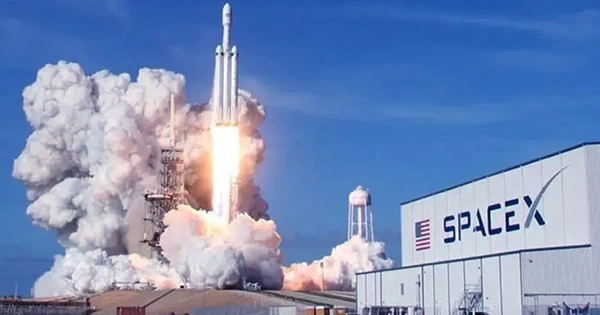Strangely, SpaceX claims that its upcoming Starlink mission will place 54 satellites into low Earth orbit (LEO), suggesting that these satellites will be similar in size to the V1.5 satellites that the company is already launching rather than the larger V2 or V2 Mini satellites that have been the subject of recent FCC filings.
However, the information offered by SpaceX also reveals that those 54 satellites are only going to an orbit that corresponds to the company’s upcoming Starlink Gen2 (V2) constellation. Although SpaceX secretly said in a supplemental October 2022 filing [PDF] with the FCC that a V1.5-sized satellite was a possibility for early Gen2 launches, it is still unclear why SpaceX would prioritize launching V1.5-sized V2 satellites while its V1 network is still under construction.
Elon Musk, CEO of SpaceX, firmly hinted in November 2021 that if the company couldn’t start launching larger V2 satellites on its next-generation Starship rocket by the end of 2022, the inefficiencies of smaller Starlink V1.x satellites could risk driving SpaceX into bankruptcy. Then what does SpaceX’s upcoming “Starlink G5-1” launch aim to accomplish?
Even the name itself is unclear. The initial launch of a constellation’s “Group 5” is referred to as “G5-1” using the same abbreviation as previous Starlink V1 launches. A group of satellites with a comparable orbital inclination (the angle at which the orbit crosses the equator) and orbital height is referred to as a “shell” in this context. Only one of the three constellations SpaceX has been granted approval for contains five shells, and that shell can only exist at 97.6 degrees, not 43 degrees. There are nine planned shells for SpaceX’s Gen2 constellation, but the FCC has only partially cleared three of them, one of which is at 43 degrees.
Aspects of the Starlink V2 satellite modifications may be applicable to SpaceX’s first-generation Starlink constellation without requiring an updated FCC license, despite the confusing moniker. This is because those enhancements are not necessarily linked to the significantly greater size of those satellites. SpaceX would almost probably need to request an updated license from the FCC, which might take months if it wanted to add larger satellites to its V1 constellation or change the frequency ranges they operate in.
SpaceX has not done this, and any attempt would result in public documentation. SpaceX’s secret “Starlink G5-1” launch is aiming for a 43-degree inclination, which excludes any participation in its V1 constellation because that constellation is only authorized for satellites with an inclination between 53 and 97.6 degrees.
Other than the improbable likelihood that information regarding the Starlink 5-1 mission is inaccurate in some way or a byproduct of a convoluted launch licensing process, there is at least one other improbable explanation. The FCC authorized SpaceX to launch a constellation of 7518 Starlink satellites in very low earth orbit (VLEO) in October 2018. These satellites would be similar in size to the 4408 satellites the company is currently launching. SpaceX has yet to start launching its authorized VLEO constellation more than four years after it was approved.
In order to lower the overall number of Starlink satellites SpaceX needed to launch, SpaceX informed the FCC in November 2022 that it intended to integrate its Starlink VLEO and Starlink Gen2 constellations by attaching V-band antennas to some of the about 33,000 Gen2 spacecraft it hoped to deploy. Around the beginning of the month, the FCC partially approved SpaceX’s application for a Starlink Gen2 license, adding unusually stringent criteria and only allowing the launch of 7500 of the 33,000 Gen2 satellites planned for that time period to specific inclinations (33, 43, and 53 degrees).
Therefore, it’s possible that the ambiguity brought up by the FCC’s odd partial Gen2 grant caused SpaceX to reconsider creating a dedicated Starlink VLEO constellation. SpaceX’s VLEO network, however, is trapped using the same smaller (and possibly bankrupting) satellites that its CEO says render the original Starlink V1 constellation unsustainable in the absence of a license amendment. The VLEO constellation’s first deployment milestone will be reached in less than two years, by which time SpaceX will need to have launched half of the constellation (3759 satellites) in order to avoid FCC penalties, including license revocation.
Even though there are many reasons why Starlink 5-1 shouldn’t be SpaceX’s first Starlink VLEO launch, nearly 2500 of the company’s approved VLEO satellites were designed to operate in an oddly similar orbit: a 338-kilometer (210 mi), a 43-degree orbit that SpaceX seems to be aiming for with Starlink 5-1.
A surprise VLEO launch is a very unlikely scenario, but it’s not all that strange compared to the alternatives, which include the possibility that Starlink 5-1 is actually a V1-sized V2 launch without prior notice or warning, a V1 launch to an orbit that would specifically contravene SpaceX’s Starlink V1 FCC license, or a paperwork error that spread to the point where SpaceX distributed incorrect orbit information less than two days before launch.
Fortunately, a new theory that has emerged since the publication of this paper seems to be far more plausible. Astrophysicist Jonathan McDowell pointed out that SpaceX had, in fact, made reference to a third, smaller Starlink V2 satellite version in an October 2022 FCC filing that largely went unnoticed in response to a tweet that summarized these assertions. SpaceX informed the FCC in that submission that it was creating three variations rather than just two. The smallest version reportedly weighed 303 kilograms and had dimensions that were very equal to those of SpaceX’s current V1.5 satellites, which weigh about 307 kilograms. Again confirming that V2 satellites may be similar in size and form to V1.5 satellites, SpaceX added that the first Falcon 9 launches will carry “about twenty to sixty satellites.”
Musk’s implied allegations that issues with its smaller V1 satellites jeopardize the company’s viability make little sense in the context of SpaceX’s decision to construct a V1.5-sized version of V2 satellites. It is now more obvious than ever that the CEO of SpaceX may have fabricated an existential threat in order to get workers to put in more overtime. However, it is at best perplexing that a V1.5-sized V2 satellite variation is being developed and launched, and that this is happening while SpaceX’s Starlink Gen1 is more than 25% complete.
No matter what it’s carrying or why, Starlink 5-1 will launch from Florida’s Cape Canaveral Space Force Station (CCSFS) aboard a SpaceX Falcon 9 rocket no sooner than 4:40 am EST (09:40 UTC) on December 28.















